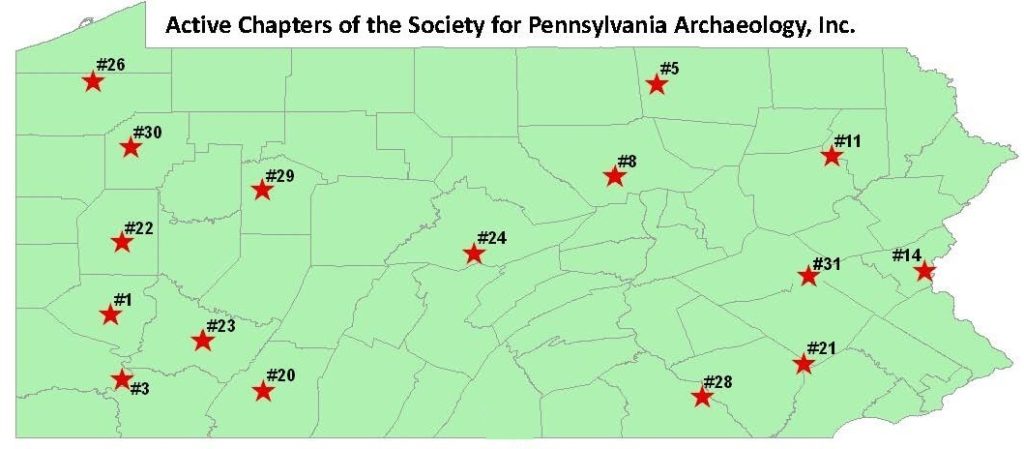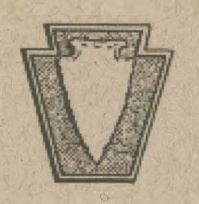This Archaeology Month, we are celebrating the Society for Pennsylvania Archaeology’s 90th year. As part of that celebration, we are taking over the Pennsylvania State Historic Preservation Office’s Blog for two weeks. Last week we looked at how the society was founded, and this week we are going to see what the Society for Pennsylvania Archaeology (SPA) looks like today. For those of you who are curious about archaeology, want to learn more, and would love the opportunity to get involved with the SPA, this blog post is for you!
What does the SPA look like at 90?
After 90 years, you would think the SPA may be stuffy and outdated, but you couldn’t be more wrong. In 2019, the SPA is as active and vibrant as ever. With around 500 members spread across the state, the society is busy promoting, learning about, and exploring the archaeology of Pennsylvania. The society as a whole is made up of local chapters that meet regularly, and once a year come together at the annual meeting. The Society’s journal, the Pennsylvania Archaeologist, is published on a regular basis in addition to a newsletter, which is published three times a year.
Local Chapters
The life blood of the SPA is the local chapters.

Currently there are 13 chapters that meet regularly; usually once a month from September to May. Chapter meetings range from informal discussions of archaeology and what people are interested in, to formal presentations about a specific topic in archaeology, to tours of local archaeology sites or museums. Attendance at the meetings ranges from 5 to 50 people and attracts all ages. Meetings are held in a variety of places including church basements, office board rooms, and even a fly-fishing store!
Some chapters have active excavation projects, which give their members a chance to experience archaeology first-hand, as well as understand the science behind archaeology and learn about how to properly record and document the findings. These chapter digs range in size from small scale testing to the excavation of large villages.
Over the years, the work conducted by local chapters has formed the foundation of what we know about the prehistory of Pennsylvania.
Annual Meeting
Once a year, the SPA has a society-wide meeting. The location of the meeting moves around the state to accommodate local chapters and members who are unable to travel.

The annual meeting is over a weekend typically in April and consists of a formal program of papers presented by professional and amateur archaeologists discussing their finds. On Saturday night, there is a banquet at the meeting hotel, which features a keynote speaker, who usually is a regionally/nationally known archaeologist.
Besides the formal presentation, there is a lot of informal discussion about local finds and sharing of ideas. There is also a fair amount of joking, sharing of stories, and laughter (especially in the hospitality room).
Other Events
Besides chapter meetings and the annual meeting, the SPA is involved in a wide range of activities, usually in conjunction with the Pennsylvania Archaeology Council, a group that represents the professional archaeology community in Pennsylvania, the Pennsylvania State Historic Preservation Office, and other similar groups.
You’ll find SPA members at events ranging from the Pennsylvania Farm Show to local history festivals, like the Jefferson County Antique Firearms and Indian Artifact Show.

You want to get involved but don’t know how?
Are you interested in archaeology? Do you have a coffee can of arrowheads that your grandpa gave you and you want to learn more? Do you think you found an artifact on your property? Does history fascinate you?
If you answered yes to any of these questions, then the SPA is the place for you. If you want to learn more, start with the SPA website. The website has all the information you need to get involved, including when and where local chapters meet, information about the annual meeting, and info about the SPA’s Journal Pennsylvania Archaeologist. You can also download past copies of the SPA newsletter on the website. Another great place to look for information about the SPA is the society’s Facebook page.
Thank you so much for joining me on this brief tour of the SPA’s history and current programs! We at the SPA are excited about turning 90 and we’re looking forward to the discoveries, the excitement, and the fun that the next 90 years will bring!
Growing up roaming the hills of western Pennsylvania, this week’s guest author, Jonathan Libbon, knew from an early age that archaeology was for him. He is currently a professional archaeologist at SWCA Environmental Consultants. He has been a member of the SPA since 2007 and is involved with the Allegheny Chapter (Chapter 1). His interests range from industrial to landscape archaeology but is passionate about pretty much all of Pennsylvania Archaeology.
Comment Policy
PHMC welcomes and encourages topic-related comments on this blog. PHMC reserves the right to remove comments that in PHMC’s discretion do not follow participation guidelines.
Commenters and Comments shall be related to the blog post topic and respectful of others who use this site.
Commenters and Comments shall not: use language that is offensive, inflammatory or provocative (this includes, but is not limited to, using profanity, obscene, or vulgar comments); disparage other commenters or people; condone illegal activity; identify the location of known or suspected archeological sites; post personal information in comments such as addresses, phone numbers, e-mail addresses or other contact details, which may relate to you or other individuals; impersonate or falsely claim to represent a person or an organization; make any commercial endorsement or promotion of any product, service or publication.
If you would like to comment on other topics not related to this blog post but related to PHMC, please fill out the PHMC Contact Us Form.

Leave a Reply